8 Best Foods to Feed your Adult and Puppy Pomsky with Our Diet and Nutrition Tips and Info
Quick Guide
- What is the Best Dog Food for a Pomsky?
- Pomsky Diet & Nutrition
- Best Foods for A Pomsky
- Ollie Healthy Turkey Feast Fresh Dog Food
- UnKibble by Spot and Tango Beef and Barley Recipe
- Merrick Grain Free Real Chicken and Sweet Potato Recipe
- Wellness CORE Grain Free Original Formula
- Earthborn Holistic Coastal Catch
- Taste of the Wild Pacific Stream Canine Formula with Smoked Salmon
- Wellness CORE Grain Free Puppy
- Canidae Grain Free Pure Foundations Puppy Formula
- How Much Should You Feed Your Pomsky?
- How Many Calories Does My Pomsky Need?
- What To Look For In A Good Pomsky Food
- Conclusion
The Pomeranian and the Siberian are both spitz-type dogs so there may be some shared ancestry in the distant past between the two parent breeds. Pomeranians were much larger in the past and were used for pulling sleds so you can see that it’s not so crazy to cross these two breeds.
If you have a Pomsky you need to feed the best Pomsky food possible to provide the nutrition your dog needs.
What is the Best Dog Food for a Pomsky?
- Ollie Healthy Turkey Feast Fresh Dog Food
- UnKibble Beef and Barley Recipe by Spot and Tango
- Merrick Grain Free Real Chicken and Sweet Potato Recipe
- Wellness CORE Grain Free Original Formula
- Earthborn Holistic Coastal Catch
- Taste of the Wild Pacific Stream Canine Formula with Smoked Salmon
- Wellness CORE Grain Free Puppy
- Canidae Grain Free Pure Foundations Puppy Formula
Pomsky Diet & Nutrition
While dogs are very diverse, they all have similar nutritional needs. Whether you have a Pomeranian, a Siberian Husky, or a giant dog, your dog needs protein, fat, carbohydrates, fiber, vitamins, and minerals in his diet. All dog foods labeled “complete and balanced” will have these nutrients but it’s important for you to look for a food that uses good quality ingredients.
Some foods use cheaper, less nutritious ingredients, and fillers instead of ingredients that are healthier for your dog. Some ingredients can sound good but they don’t really provide as much nutrition as you might think. It’s not always a matter of how much the food costs either. Some very expensive foods can contain lots of plant protein, for example, which can be hard for some dogs to digest. These foods usually have very high protein percentages but they don’t have as much animal protein as you might expect. For all of these reasons it’s important to know which ingredients are good for your dog and which ones he needs in his diet.
Since Pomskies haven’t been around very long, some of the information about them and their diet comes from what we know about their parent breeds – Pomeranians and Siberian Huskies. Hip dysplasia can occur in Siberian Huskies but it’s not common. Siberian Huskies are one of the breeds that can have problems with zinc responsive dermatosis but it’s not known if this can be passed along to a Pomsky offspring. Siberians also tend to be lactose-intolerant. Many of them can’t digest dairy products like milk, ice cream, and yogurt. Again, we don’t know if this lactose intolerance is passed along to Pomskies or not but you may want to avoid giving your Pomsky dairy products.
There are many reports that Siberians have a very efficient metabolism and digest food efficiently. They sometimes eat less food than other dogs and can skip meals. This is not a cause for concern in a Siberian as long as the dog is not losing weight. Some Pomskies that resemble their Siberian parent may also have this kind of metabolism.
Pomeranians can be prone to some skin issues, including allergies. Luxating patellas (loose kneecaps) are a frequent problem in Poms. This is only diet-related because dogs that are overweight or obese are more prone to this problem. For this reason you should be extra careful about watching your Pomsky’s weight. Becoming overweight or obese might cause a problem with luxating patellas to show up. With Poms you also have to be careful about teeth problems, as with many Toy dogs. This probably won’t be a problem in a Pomsky since they are larger and it’s less likely that they will have crowded teeth but you should take good care of your dog’s teeth throughout his life. Teeth problems can lead to problems with what your dog is able to eat. If your Pomsky seems hungry but won’t eat, have your vet check his teeth. He might have a dental problem.
Again, we don’t know which, if any, of these problems might be passed along to the Pomsky offspring of Pomeranians but you should be aware of these issues. It’s possible that your Pomsky puppy might not have any of these issues from either parent. You should probably assume that your Pomsky can eat any good quality dog food until you see some evidence of a problem.
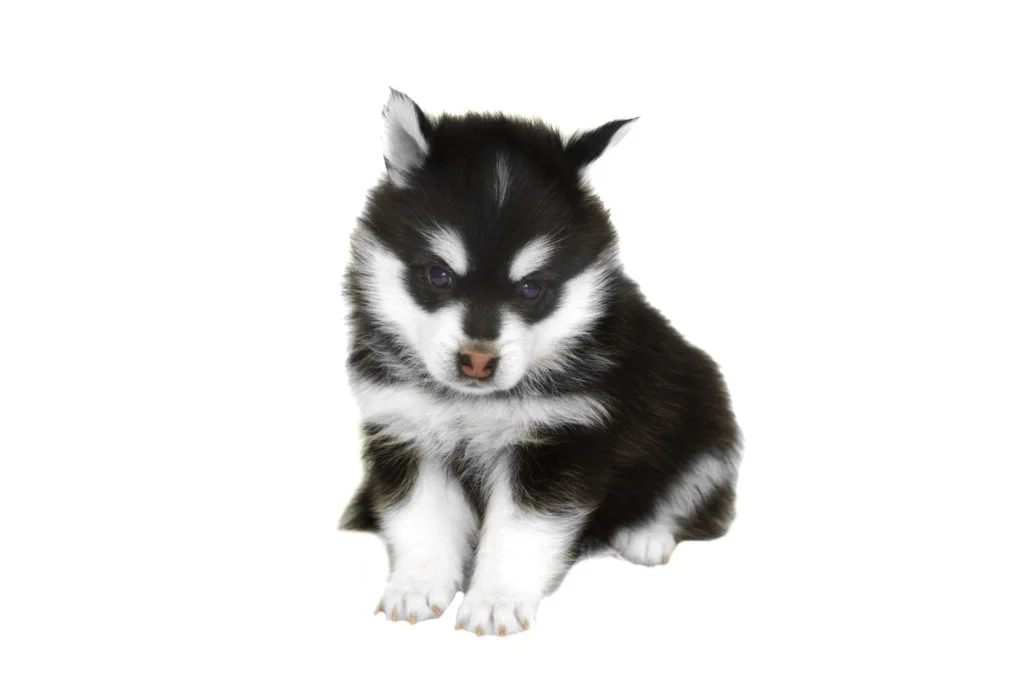
Best Foods for A Pomsky
Ollie Healthy Turkey Feast Fresh Dog Food
Healthy Ingredients : Turkey breast, turkey liver, kale, carrots, lentils
Key Features :
- Human-Grade
- Cooked to Order
- Portioned Individually for your dog
- Auto-ships direct to your door
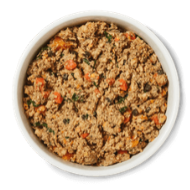
Ollie Healthy Turkey Feast Fresh Dog Food
Ollie Healthy Turkey Feast Fresh Dog Food is a human-grade, fresh food option that is delivered right to your doorstep based on a profile you fill out when you sign up. The food is cooked in small batches and doesn’t have any fillers or preservatives.
Ollie is a great fresh food option if you are in the market for a super premium dog food for your Pomsky. Just like fresh food diets are gaining popularity with humans, they are becoming popular with pets. Ollie boasts all slow-cooked ingredients which helps them to maintain their nutritional integrity, and the recipes are all human-grade. There are no artificial flavors or fillers in any of their recipes, so you can be sure that your dog is getting whole, fresh ingredients and nothing more. When you sign up for Ollie, you will fill out a profile to help them create a customized recipe and delivery schedule that will suit your pup. The food is delivered to your doorstep and stored in your fridge or freezer, ready to serve when your pet needs it. Although Ollie is more expensive than other dog foods, there are a lot of added benefits that make a fresh food diet something to consider!
UnKibble by Spot and Tango Beef and Barley Recipe
Healthy Ingredients : Beef, Barley, Flax, Carrots, Green Beans, Beef Liver
Key Features :
- Slowly dried at low temps
- Human grade ingredients
- Comes with custom portion scoop
- Convenient delivery service

UnKibble by Spot and Tango Beef and Barley Recipe
UnKibble by Spot and Tango Beef and Barley Recipe is a fresh, human-grade food made with 100% whole ingredients and no preservatives. It is slowly dried at a low temperature and comes with a perfectly sized scoop made just for your dog.
UnKibble by Spot and Tango is a dry dog food made with human-grade ingredients and no artificial flavors or preservatives. The simple and healthy recipes are developed by veterinarians, so you can be sure that your pet is getting only the best. The three recipes include the beef and barley featured here, chicken and brown rice, and duck and salmon. If you like the idea of fresh food, but need a lower price point or your dog prefers dry food, this might be for you. When you sign up, you create a unique profile that will include the correct portion size, just for your dog. You won’t have to guess or measure, just follow your pet’s personalized plan and use the scoop specially sized for your dog. Spot and Tango has never been recalled, either.
Merrick Grain Free Real Chicken and Sweet Potato Recipe
Healthy Ingredients : Deboned Chicken, Chicken Meal, Turkey Meal, Potatoes, Sweet Potatoes
Key Features :
- Supports healthy skin and coat
- Builds lean muscle
- Great for joint support
- Grain-free
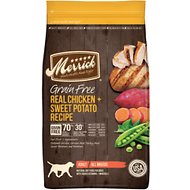
Merrick Grain Free Real Chicken and Sweet Potato Recipe
Merrick Grain Free Real Chicken and Sweet Potato Recipe has 38 percent crude protein and the recipe is designed to help build lean muscle and support a healthy coat and skin.
Because of their size and activity level, you can choose from many good quality dog foods that would be suitable for most Pomskies. Merrick Grain Free kibbles are a good choice for many dogs. The first five ingredients in the food are: deboned chicken, chicken meal, turkey meal, sweet potatoes, and potatoes. It has 38 percent crude protein and 17 percent crude fat, with 460 kcal per cup. This chicken and sweet potato formula has 70 percent meat protein which helps build lean muscles and helps supports healthy skin and coat. It’s grain free and it has no corn, wheat, soy, or gluten. And it has no ingredients from China. Merrick’s foods are made in Texas and the company tries to use locally-sourced ingredients. It also has glucosamine and chondroitin for joint support, along with omega-3 and omega-6 fatty acids, and natural antioxidants. This is an all life stage formula. Merrick has several other grain free formulas in this same product line such as beef and duck.
Wellness CORE Grain Free Original Formula
Healthy Ingredients : Deboned Turkey, Turkey Meal, Chicken Meal, Peas, Potatoes
Key Features :
- Grain-free
- No fillers or preservatives
- No meat by-products
- Packed with protein
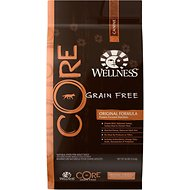
Wellness CORE Grain Free Original Formula
Wellness CORE Grain Free Original Formula is great for small and medium dogs. It is grain free and has a lot of protein.
Wellness CORE Grain Free Original Formula is a good choice for many small and medium-sized dogs such as Pomskies. The first five ingredients in the food are deboned turkey, turkey meal, chicken meal, peas, and potatoes. It’s grain free with lots of protein and it has moderate fat: 34 percent crude protein, 16 percent crude fat, 421 kcal/cup. It has no artificial flavors, preservatives, meat by-products, or fillers. Wellness CORE also has several other formulas if your Pomsky would like the ocean recipe or wild game formula.
Earthborn Holistic Coastal Catch
Healthy Ingredients : Herring Meal, Potatoes, Peas, Canola Oil (Preserved with Mixed Tocopherols, a Source of Vitamin E), Pea Protein
Key Features :
- Fish as main protein
- Grain free
- Gluten-free
- High in protein
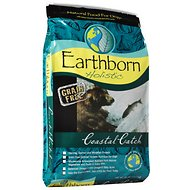
Earthborn Holistic Coastal Catch
Earthborn Holistic Coastal Catch is high in protein and grain and gluten-free. Your Pomsky might enjoy the fish in this food, too!
We suspect that your Pomsky, a spitz dog from both parents, might like some fish in his diet. For that reason, we recommend Earthborn Holistic Coastal Catch. Earthborn Holistic makes several good foods – including a very good puppy formula. This formula is high in protein and it’s grain and gluten-free. The first five ingredients are: herring meal, potatoes, peas, canola oil (preserved with mixed tocopherols), and pea protein. It also has salmon meal and whitefish meal. It has 32 percent crude protein, 18 percent crude fat, and 435 kcal/cup with just 29 percent carbohydrates. This is an all life stage formula. If your Pomsky likes fish, we think this is a good food.
Taste of the Wild Pacific Stream Canine Formula with Smoked Salmon
Healthy Ingredients : Salmon, Ocean Fish Meal, Sweet Potatoes, Potatoes, Pea
Key Features :
- Digestive enzymes
- Pre and probiotics
- 25% protein
- Grain-free
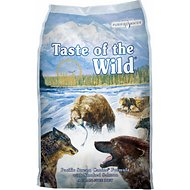
Taste of the Wild Pacific Stream Canine Formula with Smoked Salmon
Taste of the Wild Pacific Stream Canine Formula with Smoked Salmon is a really popular dog food. It is grain free and is 25% protein. It includes antioxidants and digestive enzymes along with pre and probiotics.
Fan Favorite
Taste of the Wild is extremely popular with lots of dog owners so we are happy to recommend Taste of the Wild Pacific Stream formula for adult Pomskies. This is a grain free food with a crude protein percentage of 25 percent. It has a crude fat percentage of 15 percent and 360 kcal/cup. The first five ingredients in this food are: salmon, ocean fish meal, sweet potatoes, potatoes, and peas. If your Pomsky likes fish, he should like this food. This formula also has antioxidants, digestive enzymes, pre- and probiotics, chelated minerals, and natural preservatives. Taste of the Wild has a variety of other kibble and canned formulas, many with higher protein and fat percentages, if your dog doesn’t like the Pacific Stream formula. Taste of the Wild typically offers good quality dog foods at a moderate price. Most dogs really like TOTW foods.
Wellness CORE Grain Free Puppy
Healthy Ingredients : Deboned Chicken, Chicken Meal, Turkey Meal, Potatoes, Peas
Key Features :
- Good source of calcium
- DHA for brain development
- Grain free
- No artificial flavors, colors, or preservatives
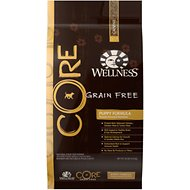
Wellness CORE Grain Free Puppy
Wellness CORE Grain Free Puppy is a great grain-free option for your Pomsky puppy. It has DHA to support brain development and the calcium level is perfect for a growing puppy.
Wellness CORE Grain Free Puppy food is a grain free food. The first five ingredients are: deboned chicken, chicken meal, turkey meal, potatoes, and peas. It has 36 percent crude protein and 17.5 percent crude fat with 417 kcal per cup. It has DHA to support brain and eye development. And it has antioxidants, probiotics, vitamins, and minerals for good immune system health. The calcium level is correctly balanced for growing puppies. This formula has no grain, corn, soy, wheat gluten, artificial preservatives, colors, or flavors. And it has no meat by-products or fillers. This would be a good food for medium-sized puppies like Pomskies.
Canidae Grain Free Pure Foundations Puppy Formula
Healthy Ingredients : Chicken, Menhaden Fish Meal, Lentils, Peas, Potatoes
Key Features :
- Good for sensitive stomachs
- Probiotics for digestion
- 30 percent protein
- Antioxidants
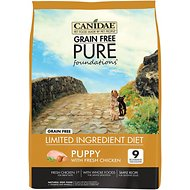
Canidae Grain Free Pure Foundations Puppy Formula
Canidae Grain Free Pure Foundations Puppy Formula is a great option for your puppy who has a sensitive stomach or a food allergy. It is grain free and has probiotics to help with smooth digestion.
Canidae Grain Free Pure Foundations Puppy Formula is recommended for many puppies, not just small or medium-sized Pomskies. The first five ingredients are: chicken, menhaden fish meal, lentils, peas, and potatoes. It has 30 percent crude protein, 12 percent crude fat, and 520 kcal/cup. This is a limited ingredient puppy food that’s formulated for puppies who may have sensitive digestion when they are just beginning to eat solid food. It’s also a good food for anyone who wants to be careful about what they are feeding their puppy. This food is grain free with probiotics, antioxidants, and the essential fatty acids (EFA) omega-3 and omega-6. Canidae also has several other good formulas for puppies and adult dogs, both grain free and foods with healthy grains.
How Much Should You Feed Your Pomsky?
How much you feed your Pomsky depends on several factors:
- How active is your Pomsky?
- How much does he weigh?
- How old is he?
- Is your dog spayed/neutered?
- What food are you feeding?
- How is your dog’s overall health?
Dogs have different metabolic rates depending on their size. In general, smaller dogs have a faster metabolic rate than bigger dogs. Very large dogs usually need about 40 calories per pound of body weight per day while very small dogs (like Pomeranians) need about 20 calories per pound of body weight per day. According to many owners and breeders, Siberians may have a slower, more efficient metabolism than other dogs their size. They often seem to eat less than you would expect.
Since Pomskies are usually between 20 and 30 pounds as adults, it’s safe to consider them to be a small to medium-sized dog.
Along with your dog’s weight, age, and other factors, you should also consider the food you’re feeding. Premium quality foods are usually more nutrient-dense than lesser quality foods. They often have more calories per ounce. You should check the label of the food you’re considering to find out how many calories (or kcal) the food contains per ounce or per cup. (Pet food companies are now required to provide this information in a format that is easy for pet owners to understand. Most companies that make kibble use kcal per cups.) If you have any trouble finding the calories on the label, check the company’s web site. The information is usually provided with the recommended feeding amounts.
If you change the food you’re feeding your Pomsky, it’s important to know how many calories the old food and the new food have. If you simply keep feeding your dog two cups of food per day you could end up giving him too many – or too few – calories since the new food could have a different amount of calories from the old food.
Shop Now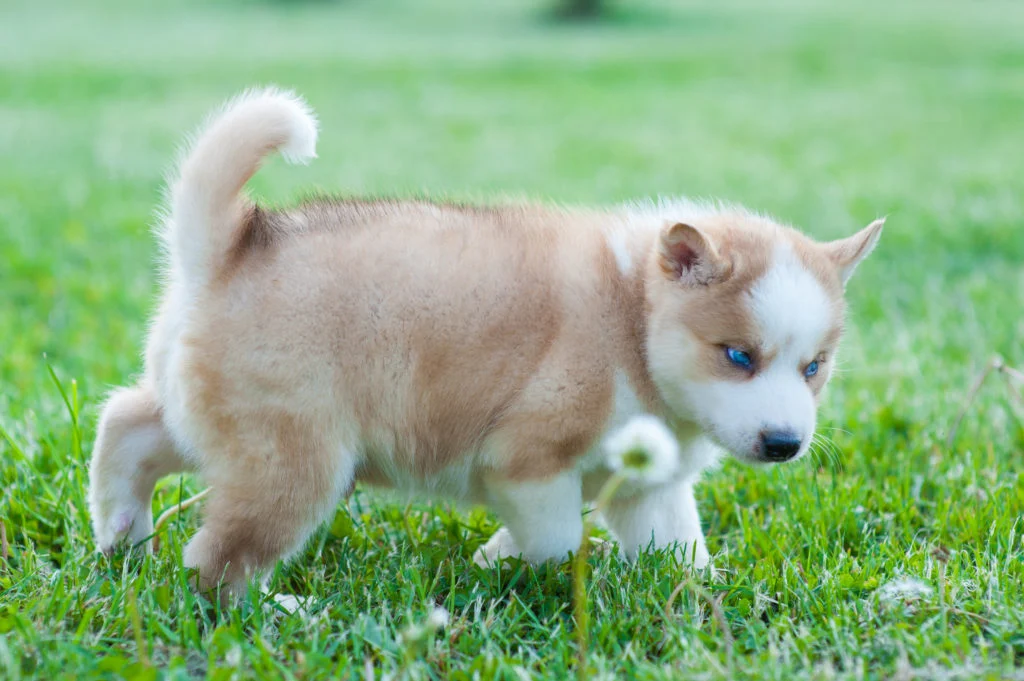
How Many Calories Does My Pomsky Need?
Based on recommendations from the National Research Council of the National Academies, the group that researches and makes nutritional recommendations for dogs and cats, if your Pomsky weighs 25 pounds you would need to feed him about 780 calories per day. This is a little more than 30 calories per pound per day which is appropriate for a medium-sized dog. If your dog is spayed/neutered or very inactive, you will probably need to reduce the calories so he won’t gain too much weight. On the other hand, if your Pomsky is very active, you might need to add a few more calories to his daily portions.
These are only suggestions. Every dog is an individual. Your Pomsky might need a few more calories or a few less. You should observe your dog to see if he’s gaining weight or losing weight, especially whenever you change dog foods. With most breeds and mixes you should be able to feel a dog’s ribs without seeing them. If you can’t feel your dog’s ribs it often means that there are layers of fat covering them.
What To Look For In A Good Pomsky Food
When choosing a good dog food for your Pomsky, look for the following:
Good Sources of Protein
The experts at Dog Food FAQ recommend that healthy adult dogs eat a diet that is higher in protein with moderate fat. Contrary to what people once believed, lots of protein in the diet doesn’t lead to health problems as long as your dog is getting all of the other nutrients he needs.
Whether you believe dogs are carnivores or omnivores (there is debate on the subject even among experts) most people do believe that dogs should have plenty of animal protein in their diet. Some of the big dog food companies will tell you that protein is protein – plant protein is just as good for your dog as animal protein. But other sources will say – and we agree – that animal protein is better for your dog. Meats and poultry like chicken, lamb, and beef; fish; and eggs are all excellent sources of animal protein for your Pomsky. Animal protein keeps your dog’s skin and coat healthy; repairs cellular damage; and builds lean muscle.
Many dog foods today use lots of plant protein in the form of peas and lentils. You find chickpeas (garbanzo beans), lentils, and peas – which usually refers to field peas or split peas – on the label of many expensive grain free dog foods. Your dog can eat these ingredients. They are some of the current substitutes for grains. They have more protein than corn and wheat along with some other nutrients. But they also tend to be high in fiber which can be a problem for some dogs. Some dogs have problems digesting these ingredients in large amounts. They also contain lots of phytates so they can interfere with the absorption of some vitamins and minerals – which is why you see so many companies using chelated minerals today to make sure dogs are absorbing the minerals they need in these foods. We don’t suggest that you should avoid grain free dog foods or feeding any plant protein. However, we do suggest that you look for foods that rely mostly on animal protein and which use less plant protein.
Ideally a good dog food will have two or three sources of animal protein in the first several ingredients. Many good foods will use a whole meat protein along with one or two named meat meals such as chicken meal or lamb meal. Some people prefer whole meats but these meats are mostly water. When the moisture is removed during the cooking process the protein in these foods would be much lower in the ingredient list. Named meat meals, by contrast, have already had most of their moisture removed. They contain mostly protein before cooking.
Good Sources of Fat
Pomskies and other dogs need good sources of fat in their diet. Fat is important because it provides essential fatty acids such as omega-3 and omega-6. It also helps distribute fat soluble vitamins – A, D, E, and K. Animal sources of fat such as chicken fat and fish oil are better for your dog than most plant oils since he is able to use them better. For example, many dog foods use flax seed which is a source of plant protein and dietary fiber. However, as a source of omega-3 it’s useless to dogs. Dogs are not able to convert it to a usable form. If you want your dog to have omega-3 it needs to come from an animal source such as fish.
Named Ingredients
Avoid generic ingredients. Instead, look for named ingredients in your dog’s food. With generic ingredients you don’t really know what you’re feeding your dog. The ingredient could be something undesirable or even harmful to your dog. The more specific the ingredient is, the better. For example, chicken meal is better than “meat meal.” Chicken fat is better than “animal fat.”
Low to Moderate Carbohydrates
Current research shows that dogs have evolved to digest starches. This makes them different from their wolf ancestors. Many experts state that dogs don’t need carbohydrates in their diet but we disagree. Carbohydrates include ingredients such as probiotics, fiber, and other nutrients which are important to your dog’s nutritional needs. Your dog doesn’t need empty calories or filler ingredients. Your dog doesn’t need dog foods that contain 50 percent carbohydrates. But that doesn’t mean that some carbohydrates in the diet don’t serve a purpose.
Many dog foods today probably have more carbs than you expect. Even some of the most expensive dog foods can have loads of carbohydrates. Many grain free foods use ingredients that are high in carbs such as sweet potatoes, potatoes, and tapioca to take the place of grains. While these ingredients can be healthy foods on their own, when they are added together in a dog food they can add up to a lot of carbohydrates in some cases.
We think that carbohydrates have their place in dog foods. Some carbs can help keep your dog’s blood sugar level steady so he isn’t hungry all the time. We suggest looking for foods that are low to moderate in carbohydrates. This can include some low grain dog foods that use oats and barley or other less common grains.
Dog food companies are not required to provide information about the carbohydrates percentages in their foods so you may have to figure out this information yourself. Or you can contact the company and ask for it Or check the dog food reviews on Pawster.com.
Avoid Lower Quality Ingredients
You should always avoid dog foods that use lower quality ingredients. These ingredients include corn and wheat gluten; meat digest; animal digest; and unnamed meat by-products.
Avoid Artificial Preservatives, Colors, and Sweeteners
Artificial preservatives and colors/dyes have been linked to various health problems in humans and animals. You should avoid these ingredients in dog foods. Your dog doesn’t need any kind of artificial sweetener and he doesn’t care about the color of his food. Colorings and dyes are only added to appeal to you, the dog owner.
AAFCO
AAFCO is the Association of American Feed Control Officials. AAFCO sets voluntary standards for pet food labeling. Look for foods that have met AAFCO’s minimum standards. These foods will have a nutritional adequacy statement on the label that says something like: “X Recipe is formulated to meet the nutritional levels established by the AAFCO Dog Food Nutrient Profiles for maintenance.” Foods can also meet AAFCO standards by conducting food trials. Other statements may say that the food is for “All Life Stages;” or for “Growth and Reproduction.”
Most dog food experts recommend that dogs should eat a diet that is relatively high in protein and moderate in fat. A healthy adult Pomsky should be able to eat this kind of diet but remember that every dog is an individual. You should feed your dog the kind of diet that suits him best based on watching him, paying attention to his skin and coat, his activity level, and his overall health and condition.
| Pomsky Dog Food Comparison Table | |||
| Rank | Product | Price | Rating |
| Human Grade |
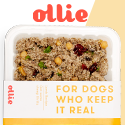 | Varies |
A+
|
| Best Dry |
 | Varies |
A+
|
| #1 |
 | $2.27/lb |
A+
|
| #2 |
 | $2.30/lb |
A+
|
| #3 |
 | $1.68/lb |
A
|
| #4 |
 Taste of the Wild Pacific Stream Canine Formula with Smoked Salmon | $1.63/lb |
A
|
| #5 |
 | $2.31/lb |
A+
|
| #6 |
 | $2.37/lb |
A
|
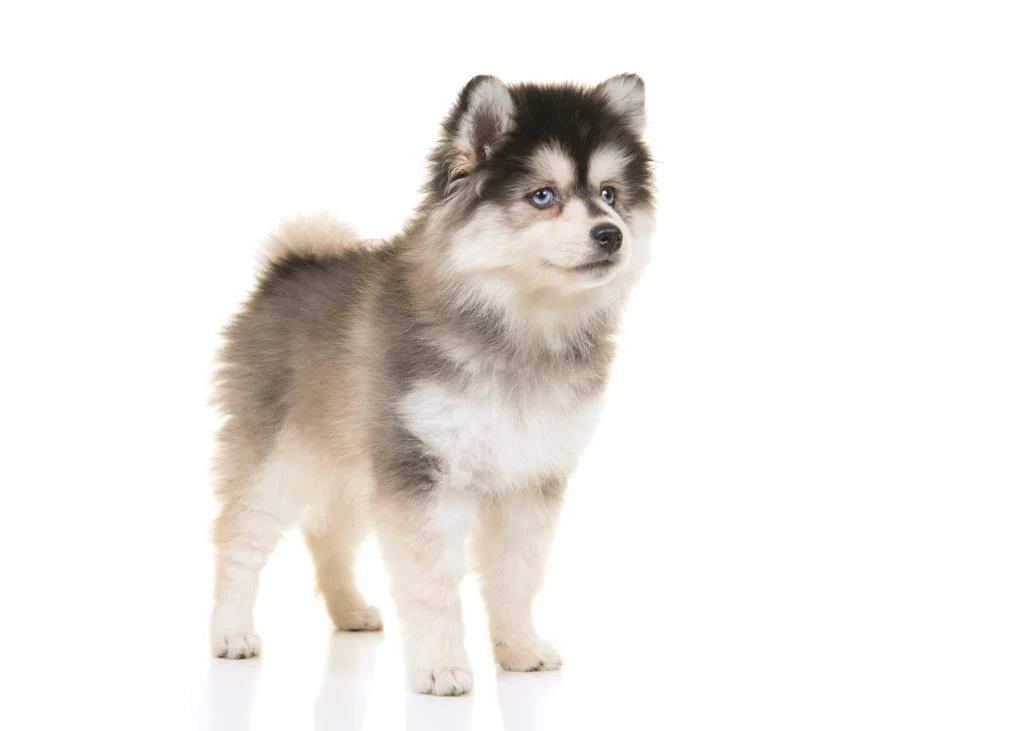
Conclusion
We hope this information helps you choose the best food for your Pomsky. These foods are only suggestions. Every dog is an individual. There are lots of good dog foods that your dog might be able to eat. Use these recommendations as a starting point and if you need more ideas check out our dog food reviews here on Pawster.






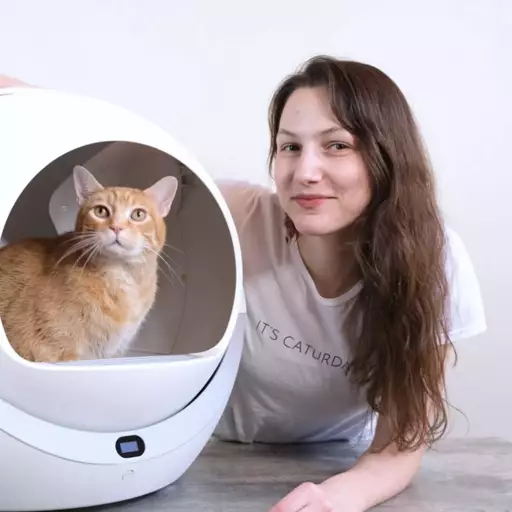


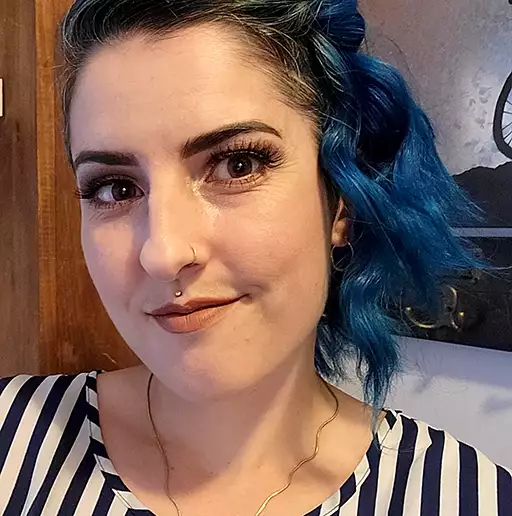


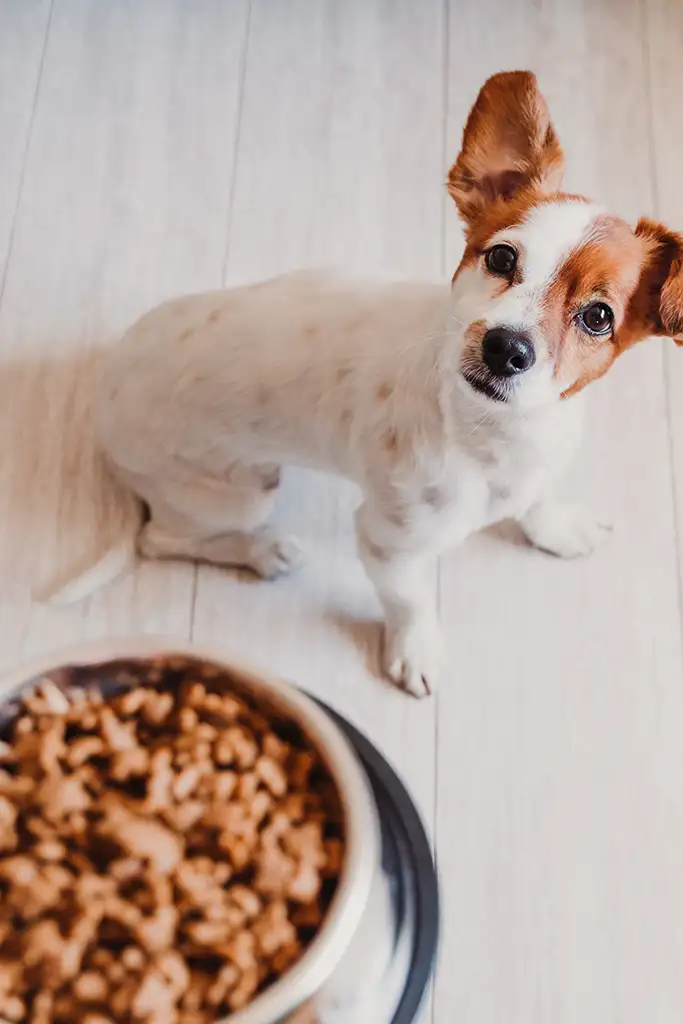
I have one little pomsky. I feed always feed him quality food. But sometimes he doesn’t digest the food. Thank you for sharing the diet for pomsky. I want to make my pet active and energetic.